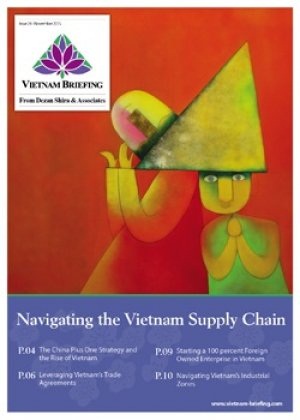Vietnamese Labor Under TPP: A Guide to Commitments and Compliance
 By: Dezan Shira & Associates
By: Dezan Shira & Associates
Editor: Aysha Nesbitt
Vietnam is on its way to being the largest beneficiary of the Trans-Pacific Partnership (TPP). The agreement will produce greater access to foreign markets and foreign direct investment for Vietnam through the reduction of 18,000 tariff lines on industrial and agricultural products. However, in order to gain access to these reductions, Vietnam is expected to comply with labor standards outlined in the agreement as well as specific commitments made under the US-VN Plan for Enhancement of Trade and Labor Relations.
TPP Labor Standards
A predictable portion of the TPP’s labor standards require Vietnam to abolish forced or compulsory labor, including child labor. The country must also actively discourage the importation of goods from sources where products are in whole or partially produced by forced labor. In order to ensure this policy is strictly followed, Vietnam will be required to establish a labor council of government representatives who will monitor the implementation of the labor reforms.
Once the TPP comes to fruition, the council will be responsible for reviewing and accessing the reforms at the end of the first year and every two following. Other reforms that Vietnam must establish are acceptable conditions of work pertaining to minimum wage, hours of work, as well as safety and health conditions. Each province in Vietnam will be responsible for implementing, regulating, and maintaining these reforms to the satisfactory degree.
 RELATED: Dezan Shira & Associates’ Corporate Establishment Services
RELATED: Dezan Shira & Associates’ Corporate Establishment Services
US-VN Plan for Enhancement of Trade and Labor Relations
While compliance with basic guidelines outlined in the TPP’s labor standards will be sufficient to qualify Vietnam’s goods for tariff reductions in the majority of states party to the agreement, tariff reductions from United States will only come as a result of more stringent reforms outlined under the US-VN Plan for Enhancement of Trade and Labor Relations. Currently standing at an average of 7.9 percent for textiles and 11.4 percent for clothes, US tariffs will be removed once officials determine that Vietnam has complied with guidelines covering the following areas:
- Formation and membership of labor unions
- Autonomous administration of labor unions
- Worker representation in non-unionized workplaces
- Selection of union officials
- Interference in organizational activity
- Consistency of other laws
- Treatment of strikes
- Forced labor
- Discrimination in the workplace
Enforcement
Ultimately, Vietnam’s participation in TPP will be tied to its compliance with labor reform regulations. However, the level of enforcement of these standards will likely be an important factor to consider as well. Currently, there is large doubt surrounding whether or not the standards set forth in both TPP and Vietnam’s bilateral arrangement with the united states will be enforced in a manner that is as stringent as it has been intended. As many of the penalties of the agreements are flexible, there is every reason to believe that Vietnam may be able to tap into tariff reductions even if it fails to implement labor standards in their full form.
The TPP’s labor commitments for example suggests that the freedom to unionize will force stronger regulation, yet at the same time they set out a five-year grace period for Vietnam’s implementation. As companies begin to benefit from the TPP, it is unlikely that governments will withhold Vietnam’s involvement even if a labor misconduct is identified. As the TPP comes into force, it will be important for companies to consider and evaluate the ways in which agreements are being implemented to identify the likelihood that preferential trade will be available.
 Related: Mass Fish Deaths and the Future of Environmental Regulation in Vietnam
Related: Mass Fish Deaths and the Future of Environmental Regulation in Vietnam
The Benefits of Compliance
Following the requisite level of compliance with TPP’s standards and bilateral commitments made with the United States, Vietnam’s push for stronger labor standards along with its high skilled labor, low labor costs, and location within ASEAN, is expected to increase FDI in the manufacturing industry to around US $20 billion by 2020. A competitive manufacturing environment has been proven particularly effective in encouraging investment from export-oriented manufactures, such as those found in the textile and garment industries.
Japanese garment-textile companies have already made strides to increase production in Vietnam since the signing of the partnership. With additional investments from China, Taiwan, South Koran and India, more than US $1 billion investments have been made in the garment and textile industry, which can expect to double in the coming years.
As investments have spiked in recent years, small garment and textile enterprises have struggled to compete with increasing competition from larger firms and have in some instances been forced to enter other sectors. For those remaining, the impending implementation of TPP has promoted a wave of mergers and acquisitions as foreign investors look to take advantage of the TPP while avoiding the risks and time required to establish new operations within the country.
|
Asia Briefing Ltd. is a subsidiary of Dezan Shira & Associates. Dezan Shira is a specialist foreign direct investment practice, providing corporate establishment, business advisory, tax advisory and compliance, accounting, payroll, due diligence and financial review services to multinationals investing in China, Hong Kong, India, Vietnam, Singapore and the rest of ASEAN. For further information, please email vietnam@dezshira.com or visit www.dezshira.com. Stay up to date with the latest business and investment trends in Asia by subscribing to our complimentary update service featuring news, commentary and regulatory insight. |
![]()

Annual Audit and Compliance in Vietnam 2016
In this issue of Vietnam Briefing, we address pressing changes to audit procedures in 2016, and provide guidance on how to ensure that compliance tasks are completed in an efficient and effective manner. We highlight the continued convergence of VAS with IFRS, discuss the emergence of e-filing, and provide step-by-step instructions on audit and compliance procedures for Foreign Owned Enterprises (FOEs) as well as Representative Offices (ROs).
 Navigating the Vietnam Supply Chain
Navigating the Vietnam Supply Chain
In this edition of Vietnam Briefing, we discuss the advantages of the Vietnamese market over its regional competition and highlight where and how to implement successful investment projects. We examine tariff reduction schedules within the ACFTA and TPP, highlight considerations with regard to rules of origin, and outline the benefits of investing in Vietnam’s growing economic zones. Finally, we provide expert insight into the issues surrounding the creation of 100 percent Foreign Owned Enterprise in Vietnam.
 Tax, Accounting and Audit in Vietnam 2016 (2nd Edition)
Tax, Accounting and Audit in Vietnam 2016 (2nd Edition)
This edition of Tax, Accounting, and Audit in Vietnam, updated for 2016, offers a comprehensive overview of the major taxes foreign investors are likely to encounter when establishing or operating a business in Vietnam, as well as other tax-relevant obligations. This concise, detailed, yet pragmatic guide is ideal for CFOs, compliance officers and heads of accounting who must navigate Vietnam’s complex tax and accounting landscape in order to effectively manage and strategically plan their Vietnam operations.
- Previous Article Vietnam Market Watch: HSBC Growth Projections, Bank Hacking Attempts, and Obama’s Upcoming Trip to Vietnam
- Next Article The Case for Vietnamese Manufacturing









